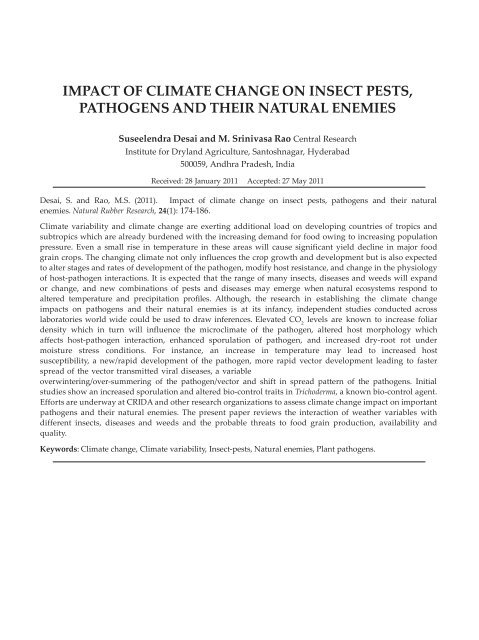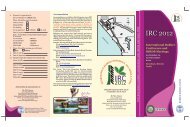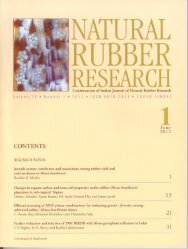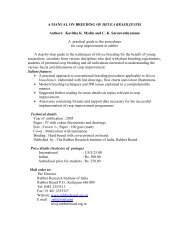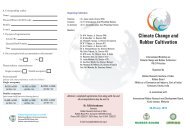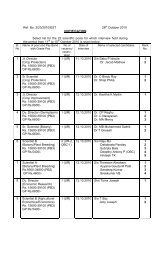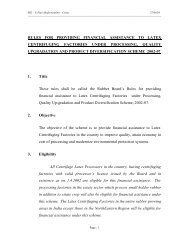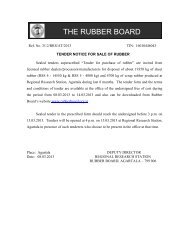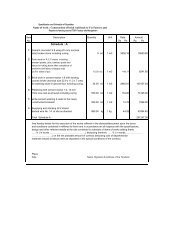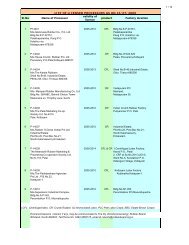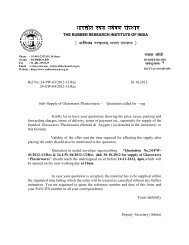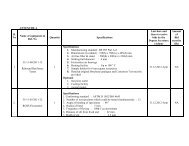to read the publication - Rubber Board
to read the publication - Rubber Board
to read the publication - Rubber Board
You also want an ePaper? Increase the reach of your titles
YUMPU automatically turns print PDFs into web optimized ePapers that Google loves.
IMPACT OF CLIMATE CHANGE ON INSECT PESTS,<br />
PATHOGENS AND THEIR NATURAL ENEMIES<br />
Suseelendra Desai and M. Srinivasa Rao Central Research<br />
Institute for Dryland Agriculture, San<strong>to</strong>shnagar, Hyderabad<br />
500059, Andhra Pradesh, India<br />
Received: 28 January 2011 Accepted: 27 May 2011<br />
Desai, S. and Rao, M.S. (2011). Impact of climate change on insect pests, pathogens and <strong>the</strong>ir natural<br />
enemies. Natural <strong>Rubber</strong> Research, 24(1): 174-186.<br />
Climate variability and climate change are exerting additional load on developing countries of tropics and<br />
subtropics which are al<strong>read</strong>y burdened with <strong>the</strong> increasing demand for food owing <strong>to</strong> increasing population<br />
pressure. Even a small rise in temperature in <strong>the</strong>se areas will cause significant yield decline in major food<br />
grain crops. The changing climate not only influences <strong>the</strong> crop growth and development but is also expected<br />
<strong>to</strong> alter stages and rates of development of <strong>the</strong> pathogen, modify host resistance, and change in <strong>the</strong> physiology<br />
of host-pathogen interactions. It is expected that <strong>the</strong> range of many insects, diseases and weeds will expand<br />
or change, and new combinations of pests and diseases may emerge when natural ecosystems respond <strong>to</strong><br />
altered temperature and precipitation profiles. Although, <strong>the</strong> research in establishing <strong>the</strong> climate change<br />
impacts on pathogens and <strong>the</strong>ir natural enemies is at its infancy, independent studies conducted across<br />
labora<strong>to</strong>ries world wide could be used <strong>to</strong> draw inferences. Elevated CO 2 levels are known <strong>to</strong> increase foliar<br />
density which in turn will influence <strong>the</strong> microclimate of <strong>the</strong> pathogen, altered host morphology which<br />
affects host-pathogen interaction, enhanced sporulation of pathogen, and increased dry-root rot under<br />
moisture stress conditions. For instance, an increase in temperature may lead <strong>to</strong> increased host<br />
susceptibility, a new/rapid development of <strong>the</strong> pathogen, more rapid vec<strong>to</strong>r development leading <strong>to</strong> faster<br />
sp<strong>read</strong> of <strong>the</strong> vec<strong>to</strong>r transmitted viral diseases, a variable<br />
overwintering/over-summering of <strong>the</strong> pathogen/vec<strong>to</strong>r and shift in sp<strong>read</strong> pattern of <strong>the</strong> pathogens. Initial<br />
studies show an increased sporulation and altered bio-control traits in Trichoderma, a known bio-control agent.<br />
Efforts are underway at CRIDA and o<strong>the</strong>r research organizations <strong>to</strong> assess climate change impact on important<br />
pathogens and <strong>the</strong>ir natural enemies. The present paper reviews <strong>the</strong> interaction of wea<strong>the</strong>r variables with<br />
different insects, diseases and weeds and <strong>the</strong> probable threats <strong>to</strong> food grain production, availability and<br />
quality.<br />
Keywords: Climate change, Climate variability, Insect-pests, Natural enemies, Plant pathogens.


